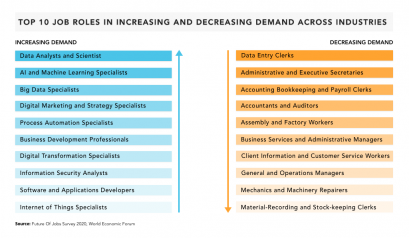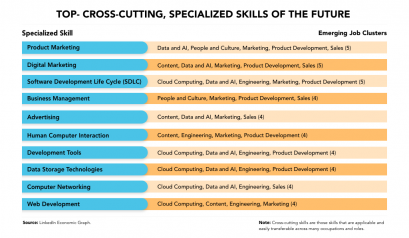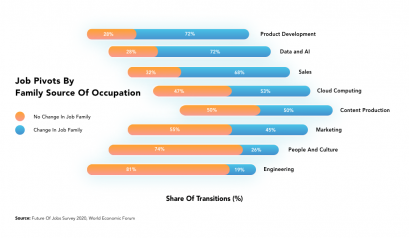“A decade’s worth of technological advancement and skills evolution is being compressed into 2020 due to COVID-19. The virus has unleashed a global ‘future of work’ experiment on us all and businesses have had to adapt at exponential speeds,”
– Anders Sörman-Nilsson
As industries, governments and other socio-political institutions strive to develop solutions that counter the Covid-19 pandemic, jobseekers, employers, and recruiters are challenged with a grim global employment scenario. Job search, career preparation, talent acquisition and management are being redefined since these last few months. Unprecedented unemployment rates across the world, are compelling job applicants and employers to rethink their risk tolerance and explore reskilling and upskilling avenues with more focus and speed. (In the US alone the number of unemployed stood at 12.6 million in Sep’20 while Australia witnessed a two-decade high in the unemployment rate in June’20 reaching 7.4%).
Jobseekers, especially, confront myriad challenges: from continuous unemployment for the first time to relying on government-backed wage subsidy programs to taking up contractual and part-time jobs in industries and, locations and companies that seemed improbable not long ago. The negative job trends after Covid-19 are harsh for senior professionals with expertise in niche areas and significant experience under their belt. A common choice falls between significant pay cuts in their chosen fields or switching to different functions and industries altogether and competing with a younger, often more skilled applicant group. One in three Australians is considering changing jobs post the pandemic with 23% feeling unsure whether they have the right skills to thrive in the post-pandemic workforce and another 17% rethinking their career paths per ING. Over the course of the last few months, organizations, households and individuals inadvertently learned the meaning of ‘essential services’ and adjusted their priorities accordingly. Incidentally, ING further reveals that 12% Australians are considering a career in essential services to remain relevant in an unpredictable global job climate.
Organizations, on the other hand, are directing resources towards building action plans around the ‘future of work’, digital literacy, automation, and cybersecurity. A study conducted by IBM with C-suite executives and consumers shows 74% of the executives believing that they are helping reskilling the workforce to work in a new way while 64% of the organizations surveyed admit having shifted to more cloud-based activities and 60% claim to have adopted accelerated process automation. Furthermore, 76% of the executives surveyed plan to prioritize cybersecurity over the next two years with 46% planning to use AI to enhance cybersecurity in the same timeframe. Enterprise agility, new product development, IT resiliency, and cost management are pointed out as the top priorities per the IBM report. Enhanced digital literacy and virtual collaboration have emerged as the drivers of business operations and have ushered in a style of work touted to be the principal form in which workplaces are shaped and goals are achieved.
Key trends relating to the job market:
The coronavirus pandemic triggered a downward global job market trend with unemployment figures climbing to staggering limits.
- Take the case of Australia, with nearly a million people out of work at one point in June this year and a 29.1% decline in job ads as compared to last year.
- In the US, the number of unemployed people totaled 12.6 million as per the latest Bureau of Labor Statistics (BLS) report with the unemployment rate declining to 7.9% in Sep’20 from the previous record high of 14.7% in Apr’20. During the global financial crisis of 2008-09, the unemployment rate in the US rose from 4.7% in Dec’07 to about 10% in Jun’09, however, it just took a couple of months of the pandemic to push the unemployment rate from 3.5% in Feb’20 to 14.7% in April.
- Norway witnessed its highest unemployment rate of 10.4% since world war II.
These numbers are a story in themselves of the rapid, widespread, and deep impact of the pandemic on the global job markets and economies.
- In the United States, job gains (318,000 in Sep’20) in the leisure and hospitality sector and food services and drinking places (200,000 in Sep’20) were observed, however, these are still not significant compared to the 2.3 million job loss since Feb’20 in these sectors.
- Professional and business service sectors saw 910,000 job gains, however, employment in this sector is 1.4 million lower since Feb’20.
- The retail sector witnessed an increase of 142,000 jobs in Sep’20 while the health care and social services sector grew by 108,000 jobs in Sep’20 with primary contributors being family services, daycare services, physician offices, home health care services.
As per the latest global employment statistics revealed by LinkedIn, the most sought-after remote jobs for Aug’20 by employers consist of ‘Software Engineer’, ‘Software Architect’, ‘DevOps Engineer’, and ‘Account Manager’. The most in-demand job roles overall as listed by LinkedIn are:
- ‘Salesperson’
- ‘Registered Nurse’
- ‘Software Engineer’
- ‘Food Delivery Driver’
- ‘Financial Advisor’
‘Security Officer’ and ‘Delivery Specialist’ are listed as the new job roles topping the demand in September’20. In other countries such as Australia, healthcare and social services related jobs such ‘aged and disabled carers’, ‘Registered nurses’, ‘Child Carers’, ‘Welfare Support Workers’ have been consistently in demand across job boards and over the last few months. As per the latest data shared by the job-board SEEK– sectors such as health care and Medical (with roles concentrated in aged care, therapy, dental and medical administration), information and communication technology (with top roles being-developers, programmers, business and system analysts, software engineers and help desk and IT support). Other roles such as Network and system architects, IT security managers, cloud engineers, and Python developers are also in demand in Australia.



The World Economic Forum released a recent report with predictions and findings with respect to the global trends in the job market. The top roles as per the report from a global perspective include Product Marketing, Digital Marketing, Software Development Lifecycle (SDLC), Business Management, Advertising, and Human and Computer Interaction. The behavior of the job market indicates a compelling need to develop core skills that find congruence with emerging job roles and functions (AI, Big Data, IOT, for example) and the demand to hone competencies that increase the potential to transition from one career path to another. In light of this, the report highlights the top functions or job families with the highest scope for transitioning into alternate job functions: Product development, data and AI, sales, cloud computing, and content production.
Under these uncertain, unprecedented, and rapidly evolving conditions, candidates with the fortitude to adapt, the agility to think on their feet, the empathy to collaborate with a diverse group of people, and the desire to keep learning will edge their way towards a more meaningful job and indeed a career.
Explore the VMock platform to determine the compatibility and transferability of your core strengths and competencies with respect to a wide range of careers.





